Electromagnetic Vibrational Energy Harvesters: A Review
Abstract
:1. Introduction
2. Electromagnetic Vibrational Energy Harvesting Principles
2.1. Electromagnetic Theory
2.2. Vibration Frequency Considerations
3. Single-Magnet versus Multiple-Magnet Structures
3.1. Single Magnet Structures
3.2. Multiple Magnet Structures
4. Moving Coil vs. Moving Magnet
4.1. Moving Magnet Structure
4.2. Moving Coil Structure
5. Fabrication Technologies
5.1. Microelectromechanical Systems (MEMS) Technology
5.2. Traditional Technology
6. Circuitry
6.1. Full Wave Rectification
6.2. Voltage Multiplication and Wireless Circuits
7. Discussion
8. Conclusions
Author Contributions
Funding
Institutional Review Board Statement
Informed Consent Statement
Data Availability Statement
Conflicts of Interest
References
- Munaz, A.; Lee, B.-C.; Chung, G.-S. A Study on Vibration-Driven Electromagnetic Energy Harvester with Multi-pole Magnets. Sens. Actuators A Phys. 2012, 201, 134–140. [Google Scholar] [CrossRef]
- Yuen, S.C.L.; Lee, J.M.H.; Li, W.J.; Leong, P.H.W. An AA-Sized Vibration Based Microgenerator for Wireless Sensors. IEEE Pervasive Comput. 2007, 6, 65. [Google Scholar] [CrossRef] [Green Version]
- Peng, W.; Wei, L.; Lufeng, C. Design and fabrication of a micro electromagnetic vibration energy harvester. J. Semicond. 2011, 32, 104009. [Google Scholar]
- Mescia, L.; Losito, O.; Prudenzano, F. Innovative Materials and Systems for Energy Harvesting Applications; IGI Global: Hershey, PA, USA, 2015; pp. 254–259, 271–272. [Google Scholar]
- Sudevalayam, S.; Kulkarni, P. Energy Harvesting Sensor Nodes: Survey and Implications. IEEE Commun. Surv. Tutor. 2011, 13, 443–461. [Google Scholar] [CrossRef] [Green Version]
- Hu, Y.T.; Xue, H.; Hu, H.P. Chapter 3 Piezoelectric Power/Energy Harvesters. In Analysis of Piezoelectric Structures and Devices; De Gruyter: Berlin, Germany, 2013; pp. 72–75. [Google Scholar]
- Priya, S.; Song, H.; Zhou, Y.; Varghese, R.; Chopra, A.; Kim, S.; Kanno, I.; Wu, L.; Ha, D.S.; Ryu, J.; et al. A Review on Piezoelectric Energy Harvesting: Materials, Methods, and Circuits. Energy Harvest. Syst. 2017, 4, 3–39. [Google Scholar] [CrossRef]
- Halim, M.A.; Cho, H.; Salauddin, M.; Park, J.Y. A miniaturized electromagnetic vibration energy harvester using flux-guided magnet stacks for human-body-induced motion. Sens. Actuators A Phys. 2016, 249, 23–29. [Google Scholar] [CrossRef]
- Fastier-Wooller, J.W.; Vu, T.-H.; Nguyen, H.; Nguyen, H.-Q.; Rybachuk, M.; Zhu, Y.; Dao, D.V.; Dau, V.T. Multimodal Fibrous Static and Dynamic Tactile Sensor. ACS Appl. Mater. Interfaces 2022, 14, 27317–27327. [Google Scholar] [CrossRef]
- Matak, M.; Solek, P. Harvesting the vibration energy. Am. J. Mech. Eng. 2013, 7, 438–442. [Google Scholar]
- Beeby, S.; Tudor, M.J.; White, N. Energy harvesting vibration sources for microsystems applications. Meas. Sci. Technol. 2006, 17, R175–R195. [Google Scholar] [CrossRef]
- Zhu, Y.; Moheimani, S.; Yuce, M. Ultrasonic energy transmission and conversion using a 2-D MEMS resonator. IEEE Electron Device Lett. 2010, 31, 374–376. [Google Scholar] [CrossRef] [Green Version]
- Toshiyoshi, H.; Jub, S.; Honma, H.; Jib, C.-H.; Fujita, H. MEMS vibrational energy harvesters. Sci. Technol. Adv. Mater. 2019, 20, 124–143. [Google Scholar] [CrossRef] [Green Version]
- Zhu, Y.; Moheimani, S.O.R.; Yuce, M.R. A 2-DOF MEMS Ultrasonic Energy Harvester. IEEE Sens. J. 2010, 11, 155–161. [Google Scholar]
- Araujo, M.; Nicoletti, R. Electromagnetic harvester for lateral vibration in rotating machines. Mech. Syst. Signal Process. 2014, 52, 685. [Google Scholar] [CrossRef]
- Bouendeu, E.; Greiner, A.; Smith, P.; Korvink, J. Design Synthesis of Electromagnetic Vibration-Driven Energy Generators Using a Variational Formulation. J. Microelectromechanical Syst. 2011, 20, 466. [Google Scholar] [CrossRef]
- Akinaga, H. Recent Advances and future prospects in energy harvesting technologies. Jpn. J. Appl. Phys. 2020, 59, 110201. [Google Scholar] [CrossRef]
- Ueno, T. Magnetostrictive vibrational power generator for battery-free IoT application. AIP Adv. 2019, 9, 035018. [Google Scholar] [CrossRef] [Green Version]
- Jiang, J.; Liu, S.; Feng, L.; Zhao, D. A Review of Piezoelectric Vibration Energy Harvesting with Magnetic Coupling Based on Different Structural Characteristics. Micromachines 2021, 12, 436. [Google Scholar] [CrossRef]
- Spreemann, D.; Manoli, Y.; Folkmer, B.; Mintenbeck, D. Non-resonant vibration conversion. J. Micromech. Microeng. 2006, 16, 65. [Google Scholar] [CrossRef]
- Kraus, J.D. Electromagnetics, 4th ed.; Mcgraw-Hill, Inc.: Highstown, NJ, USA, 1992; pp. 420–427. [Google Scholar]
- Awaja, N.; Sood, D.; Vinay, T. Design and analyses of electromagnetic microgenerator. Sens. Transducers 2009, 103, 109. [Google Scholar]
- Beeby, S.P.; O’Donnell, T. Electromagnetic Energy Harvesting. In Energy Harvesting Technologies; Priya, S., Inman, D.J., Eds.; Springer: Boston, MA, USA, 2009. [Google Scholar]
- Cepnik, C.; Yeatman, E.; Wallrabe, U. Effects of nonconstant coupling through nonlinear magnetics in electromagnetic vibration energy harvesters. J. Intell. Mater. Syst. Struct. 2012, 23, 1533–1541. [Google Scholar] [CrossRef]
- Liu, L.; Yuan, F. Diamagnetic levitation for nonlinear vibration energy harvesting: Theoretical modeling and analysis. J. Sound Vib. 2013, 332, 455–464. [Google Scholar] [CrossRef]
- Lei, Y.; Wen, Z. Study on effects of the damping ratio on output performance of micro electromagnetic vibration energy harvesters. Microsyst. Technol. 2014, 21, 221–226. [Google Scholar] [CrossRef]
- Sato, T.; Igarashi, H. A New Wideband Electromagnetic Vibration Energy Harvester with Chaotic Oscillation. J. Phys. Conf. Ser. 2013, 476, 012129. [Google Scholar] [CrossRef] [Green Version]
- Halim, M.A.; Cho, H.; Park, J.Y. Design and experiment of a human-limb driven, frequency up-converted electromagnetic energy harvester. Energy Convers. Manag. 2015, 106, 393–404. [Google Scholar] [CrossRef]
- Ibrahim, P.; Arafa, M.; Anis, Y. An Electromagnetic Vibration Energy Harvester with a Tunable Mass Moment of Inertia. Sensors 2021, 21, 5611. [Google Scholar] [CrossRef]
- Liu, H.; Chen, T.; Sun, L.; Lee, C. An Electromagnetic MEMS Energy Harvester Array with Multiple Vibration Modes. Micromachines 2015, 6, 984–992. [Google Scholar] [CrossRef]
- Liu, H.; Soon, B.W.; Wang, N.; Tay, C.J.; Quan, C.; Lee, C. Feasibility study of a 3D vibration-driven electromagnetic MEMS energy harvester with multiple vibration modes. J. Micromech. Microeng. 2012, 22, 125020. [Google Scholar] [CrossRef]
- Marin, A.; Bressers, S.; Priya, S. Multiple cell configuration electromagnetic vibration energy harvester. J. Phys. D Appl. Phys. 2011, 44, 295501. [Google Scholar] [CrossRef]
- Khan, F.U.; Iqbal, M. Electromagnetic Bridge Energy Harvester Utilizing Bridge’s Vibrations and Ambient Wind for Wireless Sensor Node Application. J. Sens. 2018, 2018, 3849683. [Google Scholar] [CrossRef]
- Klein, J.A.; Zuo, L. A velocity-amplified electromagnetic energy harvester for small amplitude vibration. Smart Mater. Struct. 2017, 26, 095057. [Google Scholar] [CrossRef]
- Zorlu, Ö.; Topal, E.T.; Kulah, H. A Vibration-Based Electromagnetic Energy Harvester Using Mechanical Frequency Up-Conversion Method. IEEE Sens. J. 2010, 11, 481–488. [Google Scholar] [CrossRef]
- Yang, T.; Cao, Q. Novel multi-stable energy harvester by exploring the benefits of geometric non-linearity. J. Stat. Mech. Theory Exp. 2019, 2019, 033405. [Google Scholar] [CrossRef]
- Kim, P.; Seok, J. A multi-stable energy harvester: Dynamic modeling and bifurcation analysis. J. Sound Vib. 2014, 333, 5525–5547. [Google Scholar] [CrossRef]
- Halim, M.A.; Park, J.-Y. Modeling and experiment of a handy motion driven, frequency up-converting electromagnetic energy harvester using transverse impact by spherical ball. Sens. Actuators A Phys. 2015, 229, 50–58. [Google Scholar] [CrossRef]
- Wang, P.; Tanaka, K.; Sugiyama, S.; Dai, X.; Zhao, X.; Liu, J. A micro electromagnetic low level vibration energy harvester based on MEMS technology. Microsyst. Technol. 2009, 15, 941–951. [Google Scholar] [CrossRef]
- Saha, C.; O’Donnell, T.; Wang, N.; McCloskey, P. Electromagnetic generator for harvesting energy from human motion. Sensors Actuators A Phys. 2008, 147, 248–253. [Google Scholar] [CrossRef]
- Pancharoen, K.; Zhu, D.; Beeby, S.P. Design Optimization of a Magnetically Levitated Electromagnetic Vibration Energy Harvester for Body Motion. J. Phys. Conf. Ser. 2016, 773, 012056. [Google Scholar] [CrossRef]
- Yamaguchi, K.; Fujita, T.; Tanaka, Y.; Takehira, N.; Sonoda, K.; Kanda, K.; Maenaka, K. MEMS Batch Fabrication of the Bipolar Micro Magnet Array for Electromagnetic Vibration Harvester. J. Phys. Conf. Ser. 2014, 557, 012033. [Google Scholar] [CrossRef] [Green Version]
- Liu, X.; Qiu, J.; Chen, H.; Xu, X.; Wen, Y.; Li, P. Design and Optimization of an Electromagnetic Vibration Energy Harvester Using Dual Halbach Arrays. IEEE Trans. Magn. 2015, 51, 1–4. [Google Scholar] [CrossRef]
- Zhu, D.; Beeby, S.; Tudor, J.; Harris, N. Increasing output power of electromagnetic vibration energy harvesters using improved Halbach arrays. Sens. Actuators A Phys. 2013, 203, 11. [Google Scholar] [CrossRef] [Green Version]
- Khan, F.; Sassani, F.; Stoeber, B. Copper foil-type vibration-based electromagnetic energy harvester. J. Micromech. Microeng. 2010, 20, 125006. [Google Scholar] [CrossRef]
- Kai, T.; Guifu, D.; Peihong, W.; Qifa, L.; Zhuoqing, Y. Design and Simulation of Fully Integrated Micro Electromagnetic Vibration Energy Harvester. Appl. Mech. Mater. 2012, 152–154, 1088–1090. [Google Scholar]
- Podder, P.; Constantinou, P.; Mallick, D.; Amann, A.; Roy, S. Magnetic Tuning of Nonlinear MEMS Electromagnetic Vibration Energy Harvester. J. Microelectromech. Syst. 2017, 26, 539. [Google Scholar] [CrossRef]
- Khan, F.; Sassani, F.; Stoeber, B. Nonlinear behaviour of membrane type electromagnetic energy harvester under harmonic and random vibrations. Microsyst. Technol. 2013, 20, 1323–1335. [Google Scholar] [CrossRef]
- Sun, S.; Dai, X.; Wang, K.; Xiang, X.; Ding, G.; Zhao, X. Nonlinear Electromagnetic Vibration Energy Harvester with Closed Magnetic Circuit. IEEE Magn. Lett. 2018, 9, 6102604. [Google Scholar] [CrossRef]
- Lu, Z.; Wen, Q.; He, X.; Wen, Z. A Nonlinear Broadband Electromagnetic Vibration Energy Harvester Based on Double-Clamped Beam. Energies 2019, 12, 2710. [Google Scholar] [CrossRef] [Green Version]
- Palagummi, S.; Yuan, F.G. An optimal design of a mono-stable vertical diamagnetic levitation based electromagnetic vibration energy harvester. J. Sound Vib. 2015, 342, 330–345. [Google Scholar] [CrossRef]
- Constantinou, P.; Roy, S. A non-linear 3D printed electromagnetic vibration energy harvester. J. Phys. Conf. Ser. 2015, 660, 012092. [Google Scholar] [CrossRef] [Green Version]
- Qiu, J.; Wen, Y.; Li, P.; Liu, X.; Chen, H.; Yang, J. A resonant electromagnetic vibration energy harvester for intelligent wireless sensor systems. J. Appl. Phys. 2015, 117, 17B509. [Google Scholar] [CrossRef]
- Chen, J.; Chen, D.; Yuan, T.; Chen, X. A multi-frequency sandwich type electromagnetic vibration energy harvester. Appl. Phys. Lett. 2012, 100, 213509. [Google Scholar] [CrossRef]
- Qiu, J.; Liu, X.; Hu, Z.; Chang, Q.; Gao, Y.; Yang, J.; Wen, J.; Tang, X.; Hu, W. Multi-directional electromagnetic vibration energy harvester using circular Halbach array. AIP Adv. 2017, 7, 056672. [Google Scholar] [CrossRef] [Green Version]
- Tao, K.; Wu, J.; Tang, L.; Xia, X.; Lye, S.W.; Miao, J.; Hu, X. A novel two-degree-of-freedom MEMS electromagnetic vibration energy harvester. J. Micromech. Microeng. 2016, 26, 035020. [Google Scholar] [CrossRef]
- Zhu, Y.; Moheimani, S.O.R.; Yuce, M.R. A 2-DOF Wideband Electrostatic Transducer for Energy Harvesting and Implantable Applications. In Proceedings of the 2009 IEEE Sensors, Christchurch, New Zealand, 25–28 October 2009; pp. 1542–1545. [Google Scholar]
- Seong, T.O.K.; Salleh, H.; Nurashikin, A. Optimization of Resonator Design for Vibration-Based Electromagnetic Energy Harvester. Appl. Mech. Mater. 2013, 471, 355–360. [Google Scholar] [CrossRef]
- Jo, S.; Kim, M.; Kim, Y. Electromagnetic human vibration energy harvester comprising planar coils. Electron. Lett. 2012, 48, 874–875. [Google Scholar] [CrossRef]
- Li, Y.; Li, J.; Yang, A.; Zhang, Y.; Jiang, B.; Qiao, D. Electromagnetic Vibrational Energy Harvester with Microfabricated Springs and Flexible Coils. IEEE Trans. Ind. Electron. 2020, 68, 2684–2693. [Google Scholar] [CrossRef]
- Chae, S.H.; Ju, S.; Choi, Y.; Jun, S.; Park, S.M.; Lee, S.; Lee, H.W.; Ji, C.-H. Electromagnetic Vibration Energy Harvester Using Springless Proof Mass and Ferrofluid as a Lubricant. J. Phys. Conf. Ser. 2013, 476, 012013. [Google Scholar] [CrossRef] [Green Version]
- Chae, S.H.; Ju, S.; Choi, Y.; Chi, Y.-E.; Ji, C.-H. Electromagnetic Linear Vibration Energy Harvester Using Sliding Permanent Magnet Array and Ferrofluid as a Lubricant. Micromachines 2017, 8, 288. [Google Scholar] [CrossRef] [Green Version]
- Qiu, J.; Liu, X.; Chen, H.; Xu, X.; Wen, Y.; Li, P. A Low-Frequency Resonant Electromagnetic Vibration Energy Harvester Employing the Halbach Arrays for Intelligent Wireless Sensor Networks. IEEE Trans. Magn. 2015, 51, 1–4. [Google Scholar]
- Constantinou, P.; Roy, S. A 3D printed electromagnetic nonlinear vibration energy harvester. Smart Mater. Struct. 2016, 25, 95053. [Google Scholar] [CrossRef] [Green Version]
- Balato, M.; Costanzo, L.; Vitelli, M. Resonant electromagnetic vibration harvesters: Determination of the equivalent electric circuit parameters and simplified closed-form analysis for the identification of the optimal diode bridge rectifier DC load. Int. J. Electr. Power Energy Syst. 2017, 84, 111–123. [Google Scholar] [CrossRef]
- Balato, M.; Costanzo, L.; Vitelli, M. Maximization of the extracted power in resonant electromagnetic vibration harvesters applications employing bridge rectifiers. Sens. Actuators A Phys. 2017, 263, 63–75. [Google Scholar] [CrossRef]
- Zhang, H.; Corr, L.R.; Ma, T. Effects of electrical loads containing non-resistive components on electromagnetic vibration energy harvester performance. Mech. Syst. Signal Process. 2018, 101, 55–66. [Google Scholar] [CrossRef]
- Pan, C.T.; Hwang, Y.M.; Lin, L.; Chen, Y.C. Design and Fabrication of Vibration-Induced Electromagnetic Microgenerators. In Design and Fabrication of Self-Powered Micro-Harvesters: Rotating and Vibrating Micro-Power Systems, 1st ed.; Wiley-IEEE Press: Piscataway, NJ, USA, 2014; p. 113. [Google Scholar]
- Szabo, Z.; Fiala, P.; Dohnal, P. Magnetic circuit modifications in resonant vibration harvesters. Mech. Syst. Signal Process. 2018, 99, 832–845. [Google Scholar] [CrossRef]
- Edwards, B.; A Hu, P.; Aw, K.C. Validation of a hybrid electromagnetic–piezoelectric vibration energy harvester. Smart Mater. Struct. 2016, 25, 55019. [Google Scholar] [CrossRef]
- Beeby, S.; Torah, R.; Tudor, M.; O’Donnell, T.; Roy, S. Wireless Sensor System Powered by an Electromagnetic Vibration Energy Harvester. Meas. Control 2008, 41, 109–113. [Google Scholar] [CrossRef]
- Pan, C.T.; Hwang, Y.M.; Lin, L.; Chen, Y.C. Design and Fabrication of Self-Powered Micro-Harvesters. In Rotating and Vibrated Micro-Power Systems, 1st ed.; John Wiley & Sons, Inc.: Hoboken, NJ, USA, 2014; p. 71. [Google Scholar]
- Haroun, A.; Yamada, I.; Warisawa, S. Micro electromagnetic vibration energy harvester based on free/impact motion for low frequency–large amplitude operation. Sens. Actuators A Phys. 2015, 224, 94–96. [Google Scholar] [CrossRef]
- Xu, Z.; Shan, X.; Chen, D.; Xie, T. A Novel Tunable Multi-Frequency Hybrid Vibration Energy Harvester Using Piezoelectric and Electromagnetic Conversion Mechanisms. Appl. Sci. 2016, 6, 10. [Google Scholar] [CrossRef] [Green Version]
- Podder, P.; Amann, A.; Roy, S. Combined Effect of Bistability and Mechanical Impact on the Performance of a Nonlinear Electromagnetic Vibration Energy Harvester. IEEE/ASME Trans. Mechatron. 2015, 21, 727–739. [Google Scholar] [CrossRef]
- Cepnik, C.; Radler, O.; Rosenbaum, S.; Ströhla, T.; Wallrabe, U. Effective optimization of electromagnetic energy harvesters through direct computation of the electromagnetic coupling. Sens. Actuators A: Phys. 2011, 167, 416–421. [Google Scholar] [CrossRef]
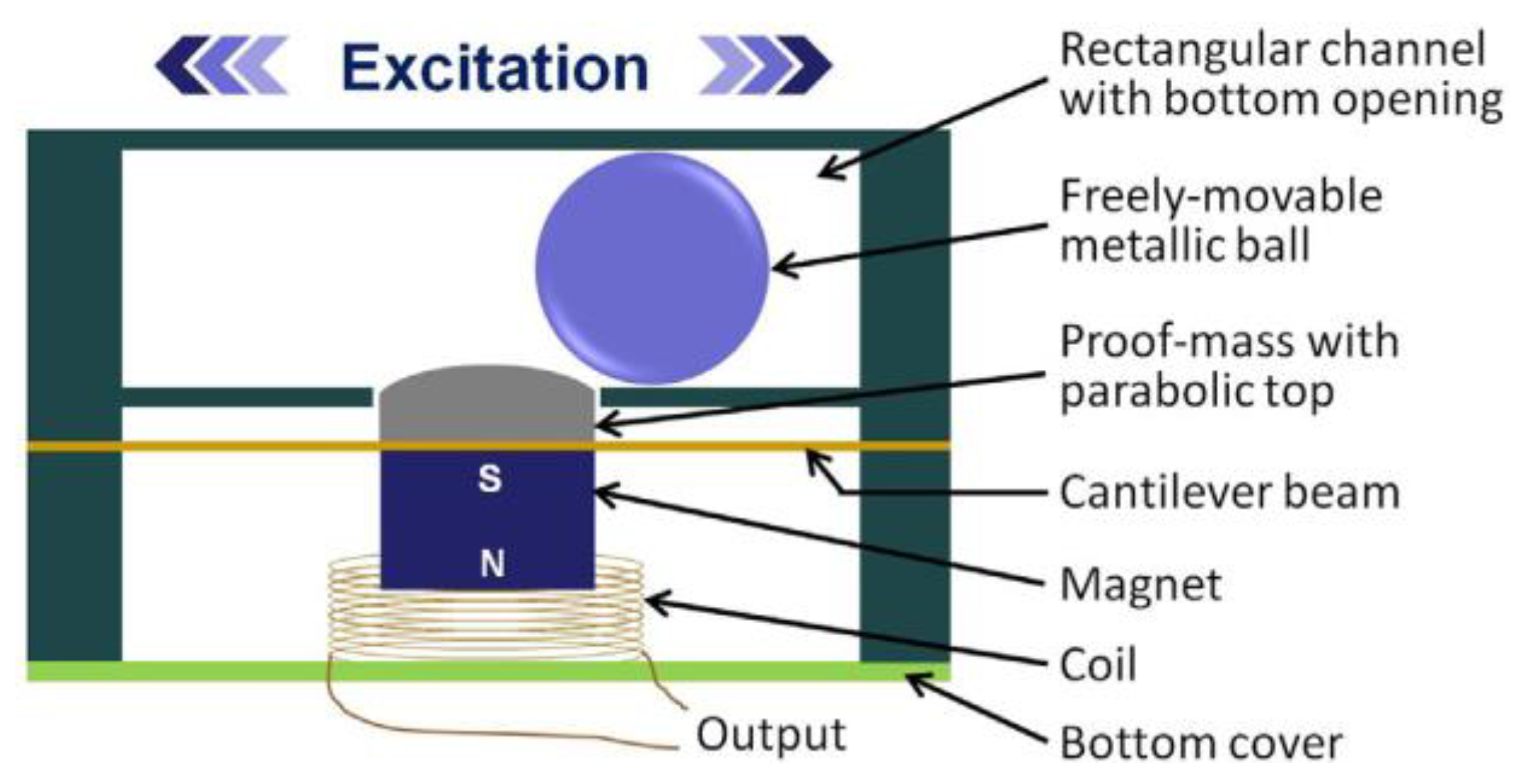
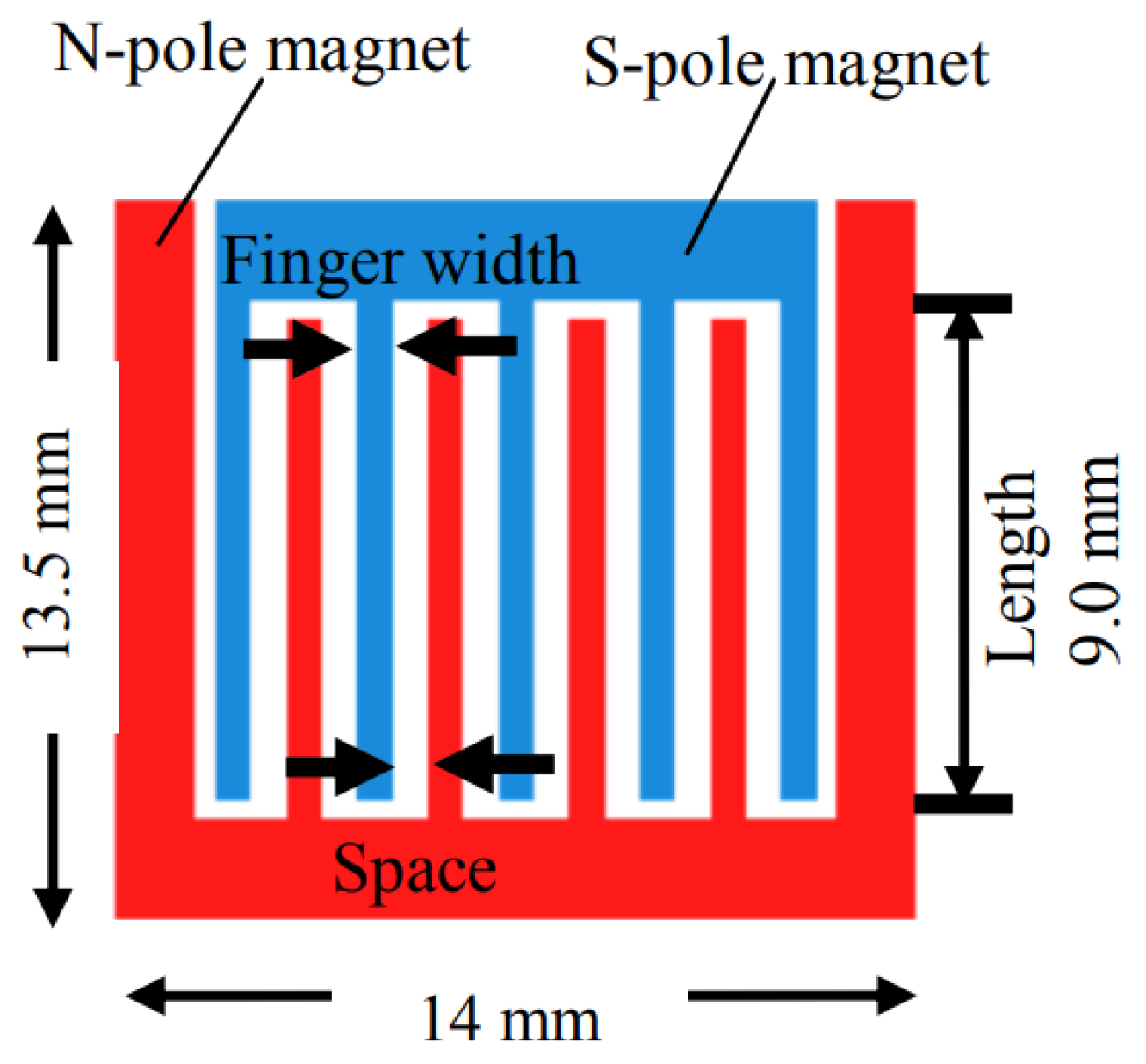
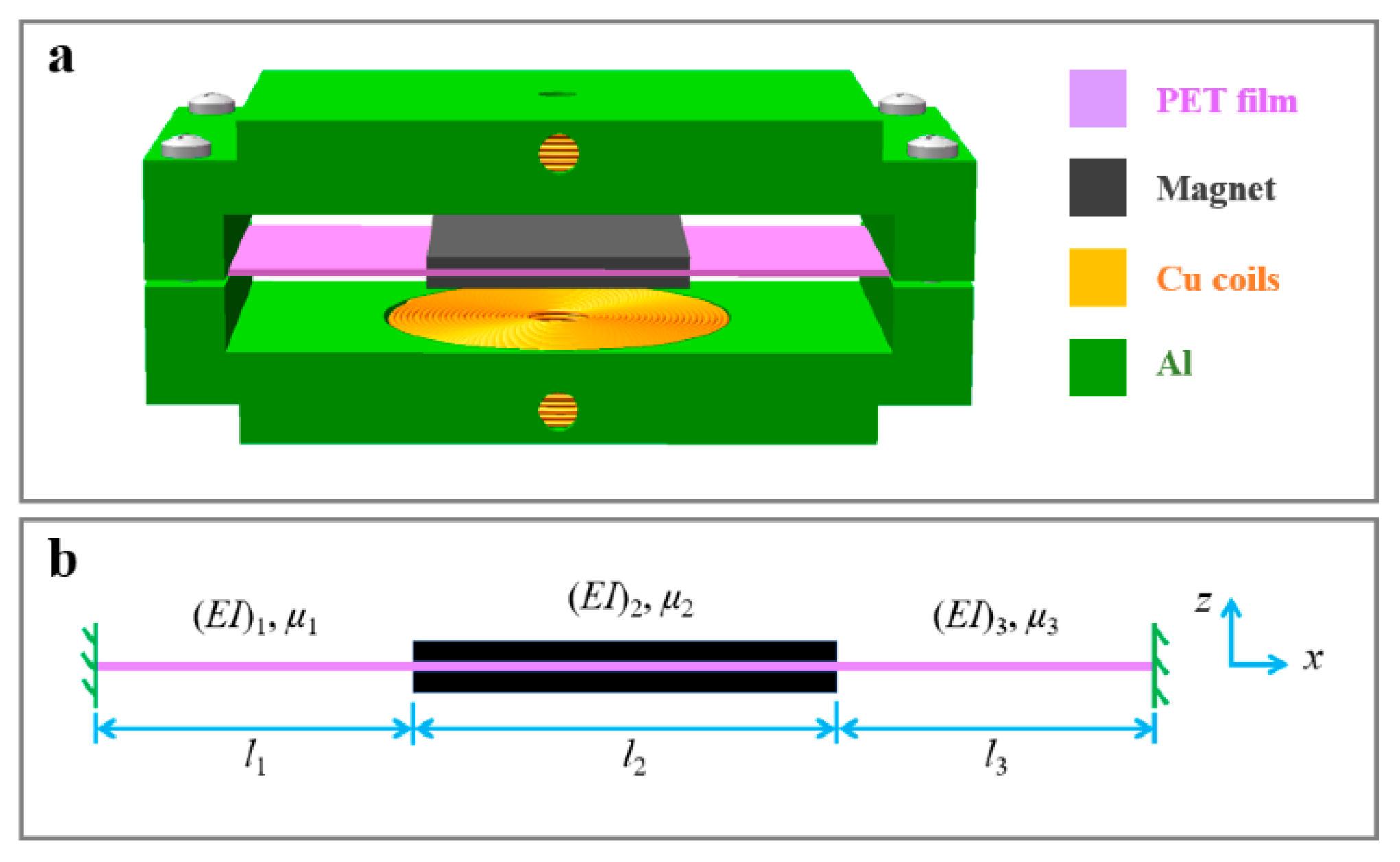
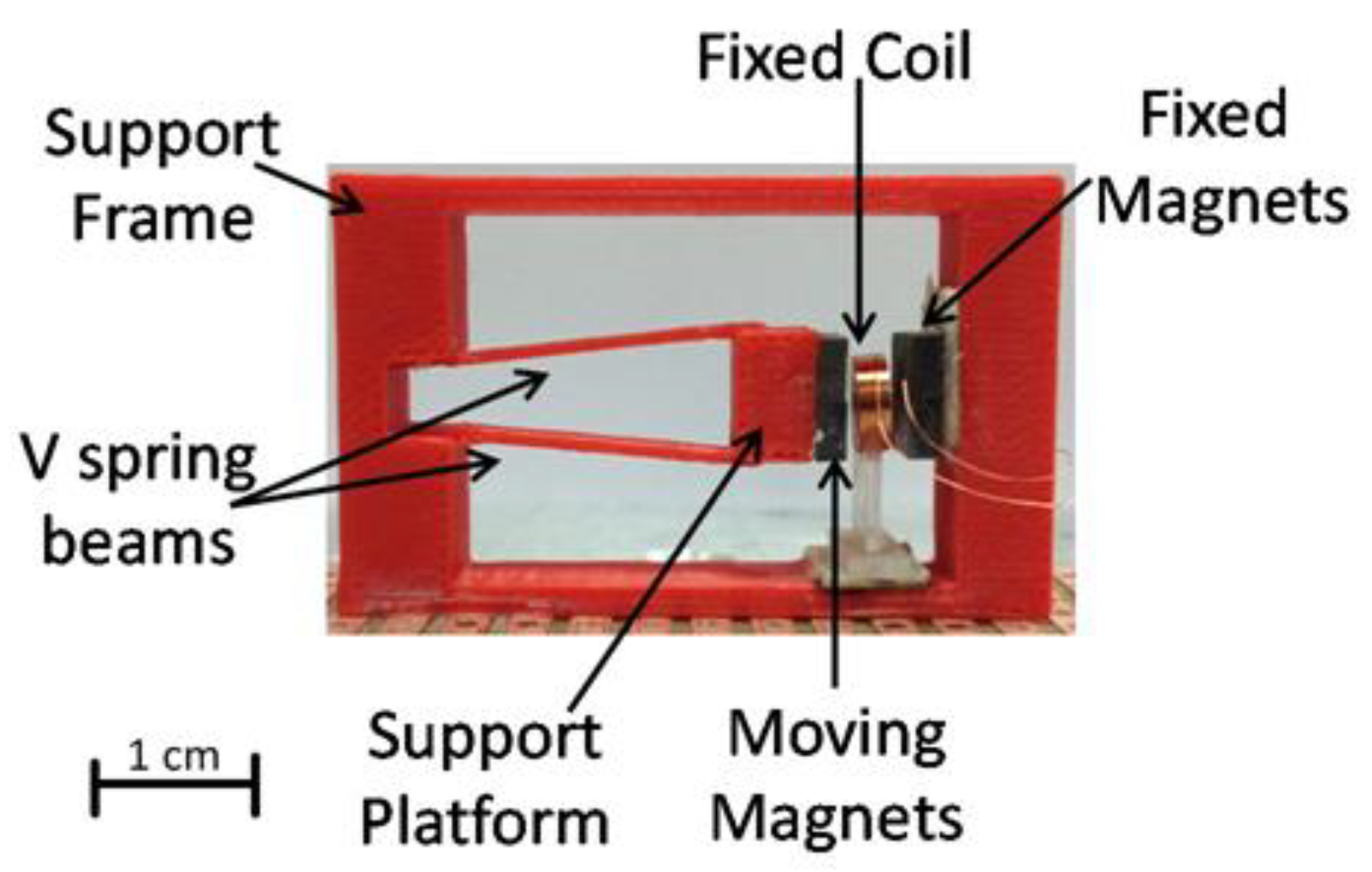
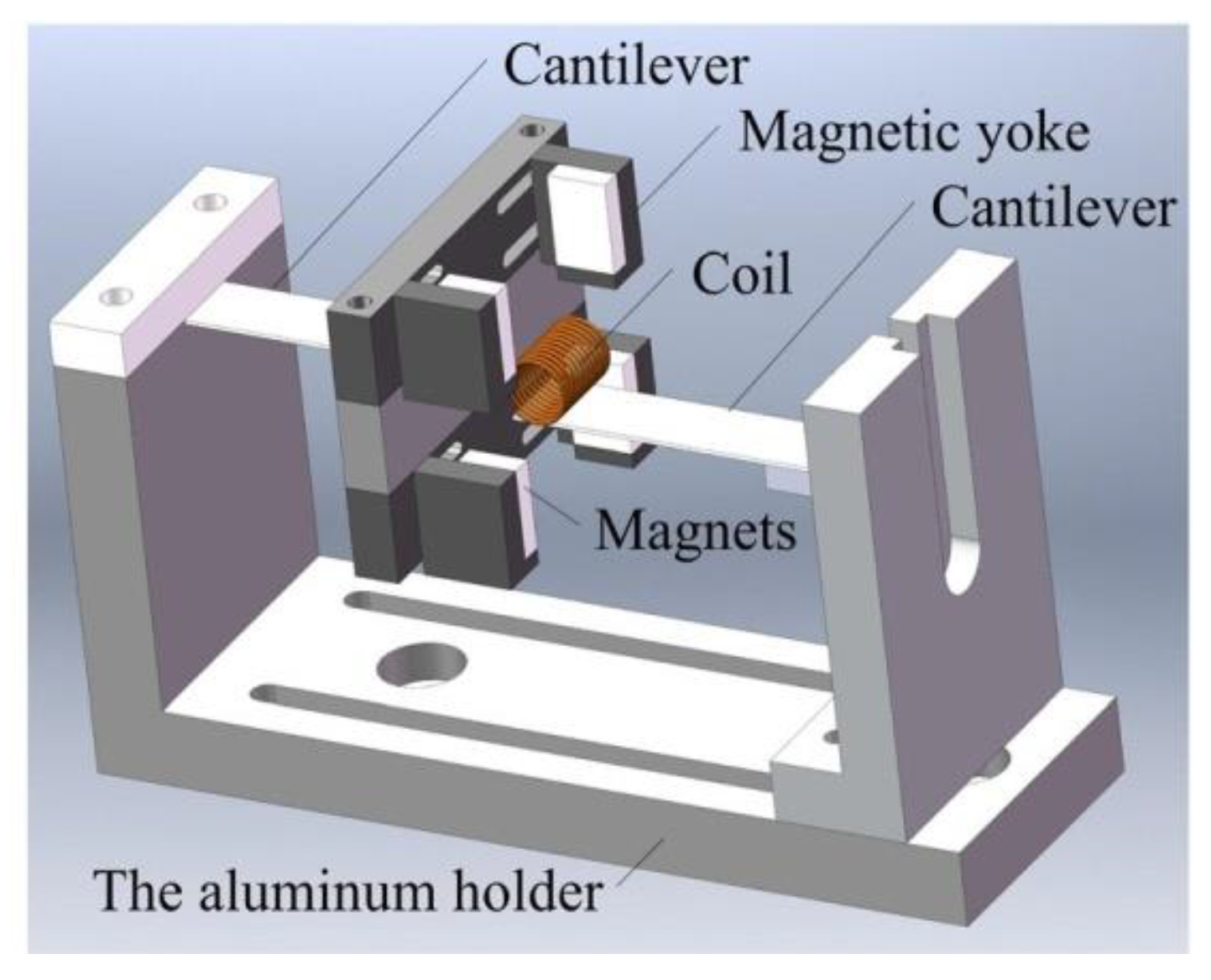
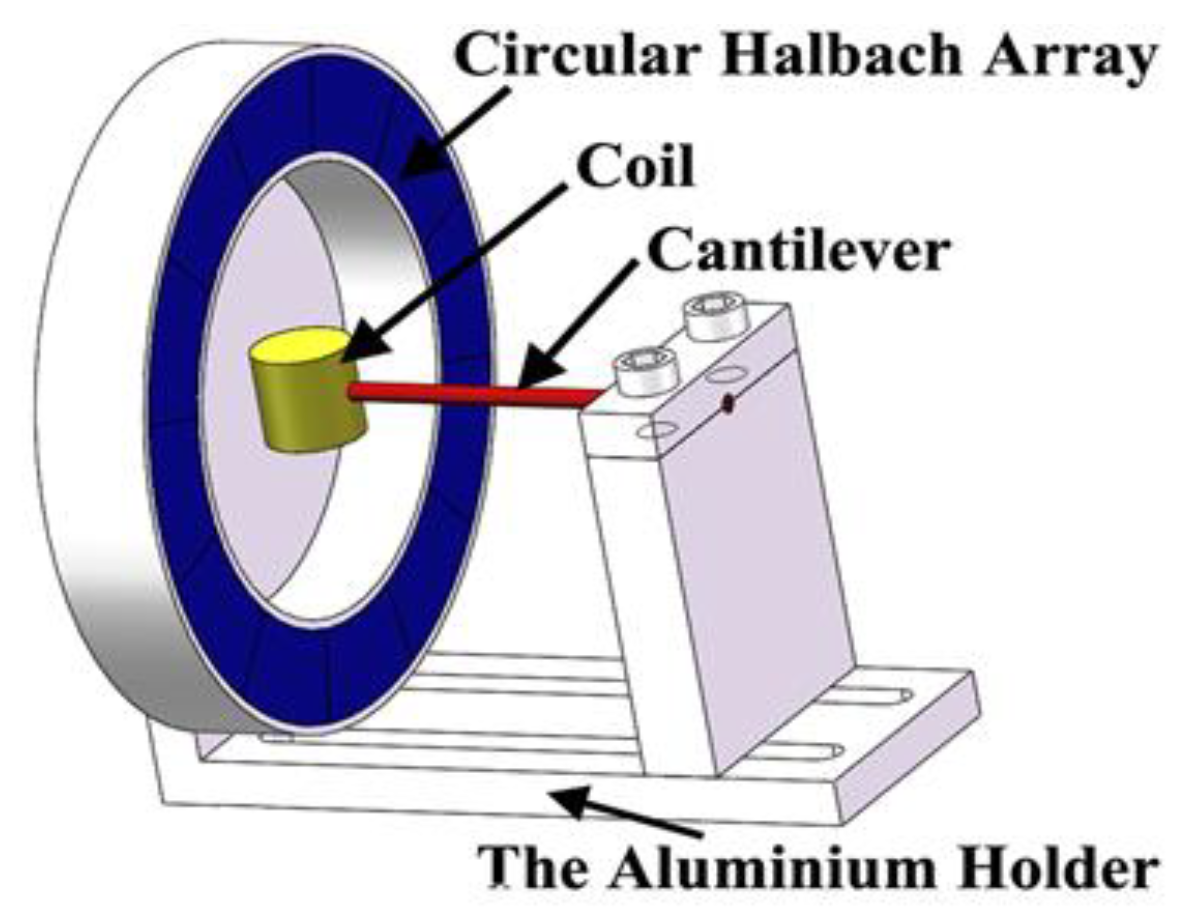
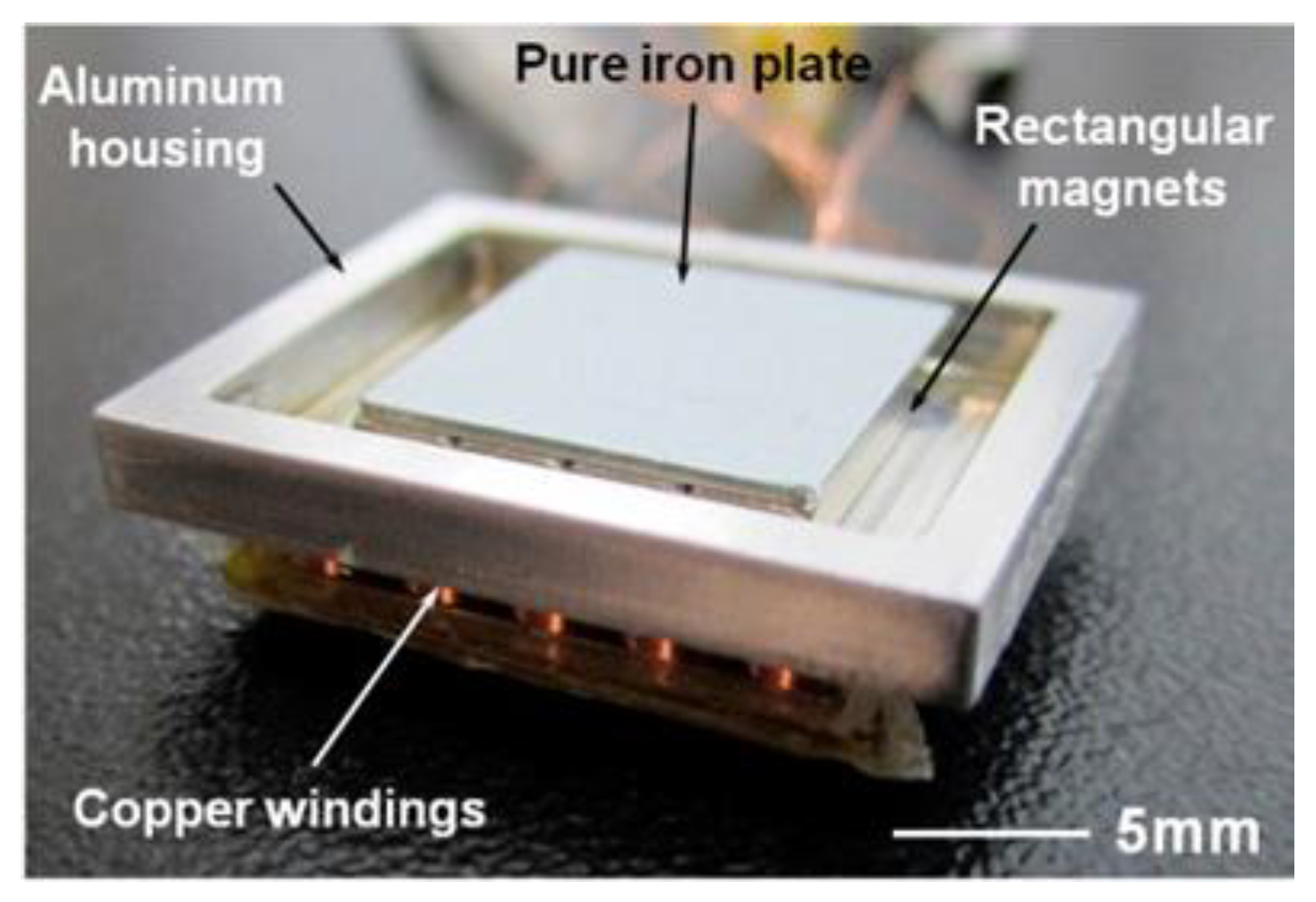
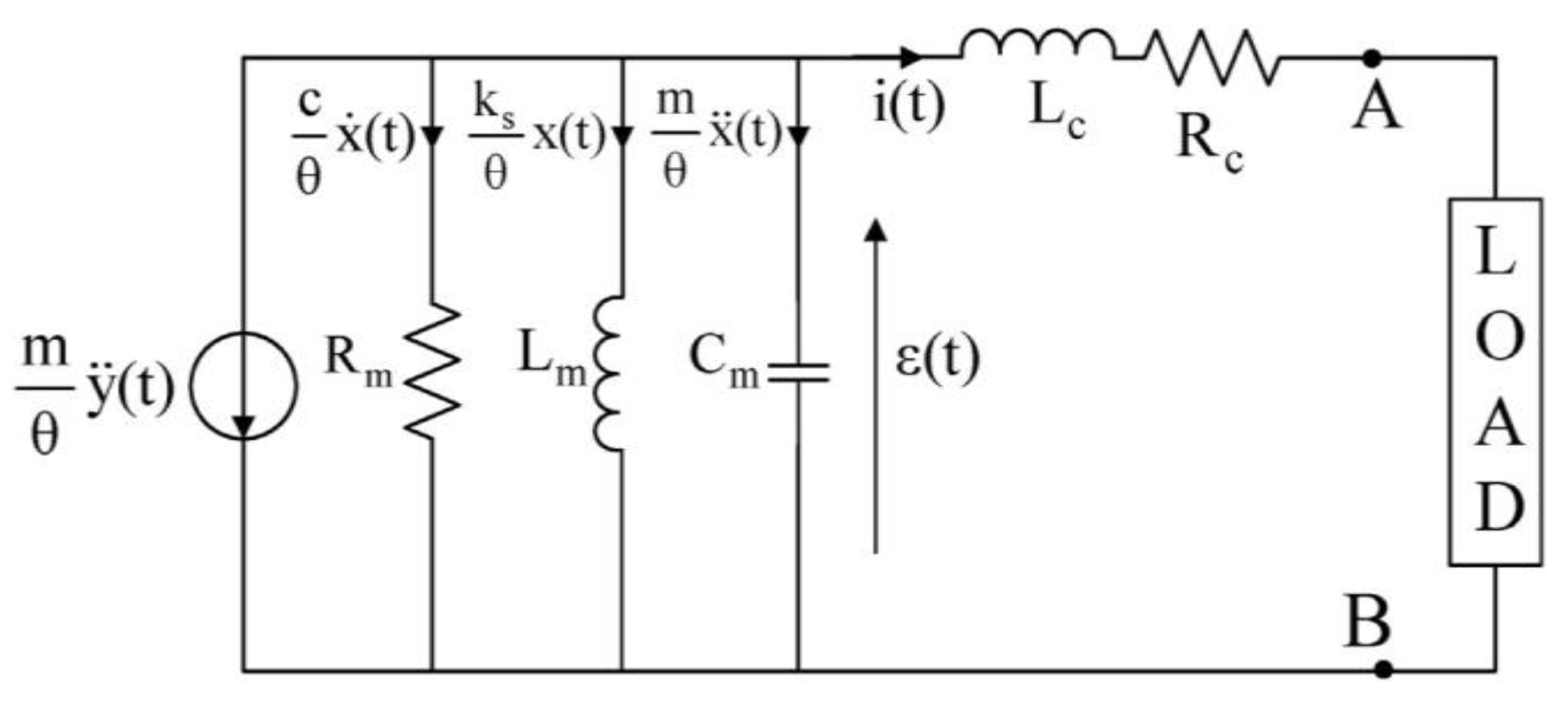
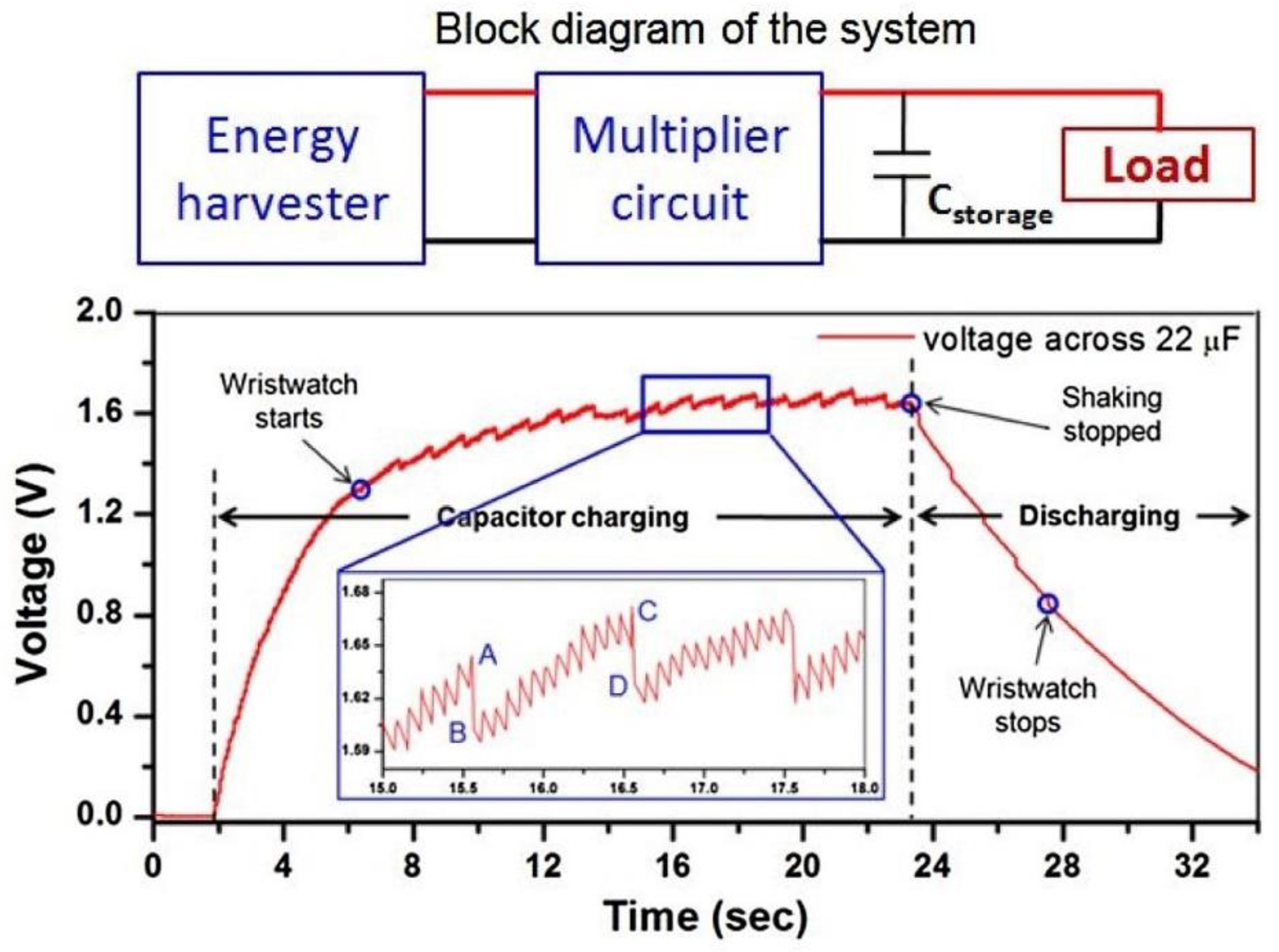
| Reference | Moving Type | No. of Magnets | Fabrication | Frequency (Hz) | Acceleration (g) | Voltage (mV) | Volume (cm3) | Power (mW) | Power Density (mW/cm3) | Normalised Power Density (mW/cm3/g) |
|---|---|---|---|---|---|---|---|---|---|---|
| [34] | both | 1 | Traditional | 19.4 | 0.019 | 910 | 125 | 2 | 0.016 | 0.842 |
| [53] | both | 4 | Traditional | 14.9 | 0.5 | 9004 | - | 50.8 | - | - |
| [46] | coil | 1 | MEMS | 391 | 0.122 | - | 0.29 | 9.6 × 10−7 | 3.3 × 10−6 | 2.7 × 10−5 |
| [31] | coil | 1 | MEMS | 1285, 1470, 1550 | - | 1.1–3.6 | 0.036 1 | 4.5 × 10−6 | 1.25 × 10−4 | - |
| [3] | coil | 1 | MEMS | 242 | 0.5 | 28 | - | 0.55 × 10−3 | - | - |
| [30] | coil | 1 | MEMS | 100–800 | - | 0.01–0.13 | 0.32 | 16.01 × 10−9 | 0.5 × 10−6 | - |
| [63] | coil | HA 2 | Traditional | 12.65 | 0.5 | - | 164 | 90.35 | 0.55 | 1.1 |
| [55] | coil | HA | Traditional | 15.4 | 0.5 | 2.08 | - | 9.32 | - | - |
| [43] | coil | HA | Traditional | 11.2 | 0.5 | 21,200 | - | - | 1.39 | 2.78 |
| [42] | coil | comb | MEMS | 400 | - | - | 0.28 | 3.12 × 10−3 | 0.011 | - |
| [38] | magnet | 1 | Traditional | 5.8 | 2 | - | 19.2 | 0.1036 | 0.0054 | 2.7 × 10−3 |
| [73] | magnet | 1 | MEMS | 3.33 | 1.26 | - | 0.763 | 0.1133 | 0.14849 | 0.118 |
| [2] | magnet | 1 | MEMS | 80 | 0.47 | 0.9 | 2.262 | 0.12 | 0.053 | 0.113 |
| [51] | magnet | 1 | Traditional | 2.1 | 0.008 | - | - | 0.00172 | - | - |
| [58] | magnet | 1 | MEMS | 422–466 | - | - | 0.161 | 0.437 | 2.714 | - |
| [59] | magnet | 1 | MEMS | 8 | 0.25 | - | - | 0.43 | - | - |
| [39] | magnet | 1 | MEMS | 55 | 14.9 | 18 | 0.13 | 6.1 × 10−4 | 4.69 × 10−3 | 3.15 × 10−4 |
| [70] | magnet | 1 | Traditional | 3 to 7 | - | 18.5 | - | 0.034 3 | - | - |
| [1] | magnet | 2 | Traditional | 4 | 0.7 | - | 83.09 | 129 | 1.552 | 2.217 |
| [20] | magnet | 2 | Traditional | 30–80 | - | - | - | 0.4–3 | - | - |
| [74] | magnet | 2 | Traditional | 25.6 | 0.2 | - | - | 2.82 | - | - |
| [8] | magnet | 2 | Traditional | - | Hand shaking | 93.5 | 3.9 | 0.203 | 0.052 | - |
| [28] | magnet | 2 | Traditional | 5.17 | 2.06 | - | 6.47 | 11.89 | 0.33 | 0.16 |
| [64] | magnet | 2 | Traditional | 147–152 | 1 | - | - | 2.9 | 0.48 | - |
| [45] | magnet | 2 | MEMS | 371 | 13.5 | 46.3 | 1.008 | - | 0.02356 | 1.745 × 10−3 |
| [48] | magnet | 2 | MEMS | 108.4 | 3 | 88.8 | 2.25 | 0.068 | 0.03022 | 0.01 |
| [52] | magnet | 2 | Traditional | 146–149 | 1 | - | 6 | 2.5 | 0.4 | 0.4 |
| [40] | magnet | 2 | Traditional | - | Walking | - | 12.7 | 2.46 | 0.19 | - |
| [16] | magnet | 2 | MEMS | 78.43 | - | 1500 | - | 0.31537 | - | - |
| [62] | magnet | 4 | Traditional | 13 | 3 | - | 1.94 | 0.493 | 2.54 × 10−4 | 8.47 × 10−5 |
| [75] | magnet | 4 | Traditional | 36 | 0.5 | - | - | 0.109 | - | - |
| [76] | magnet | 6 | MEMS | 50 | - | - | - | 20.6 | - | - |
| [41] | magnet | 8 | MEMS | - | Running | 380 | 0.565 | 0.04316 | 0.076 | - |
| [61] | magnet (ferrofluid) | 4 | Traditional | 12 | 3 | 470 | 1.94 | 0.07126 | 0.037 | 0.0123 |
Publisher’s Note: MDPI stays neutral with regard to jurisdictional claims in published maps and institutional affiliations. |
© 2022 by the authors. Licensee MDPI, Basel, Switzerland. This article is an open access article distributed under the terms and conditions of the Creative Commons Attribution (CC BY) license (https://creativecommons.org/licenses/by/4.0/).
Share and Cite
Muscat, A.; Bhattacharya, S.; Zhu, Y. Electromagnetic Vibrational Energy Harvesters: A Review. Sensors 2022, 22, 5555. https://doi.org/10.3390/s22155555
Muscat A, Bhattacharya S, Zhu Y. Electromagnetic Vibrational Energy Harvesters: A Review. Sensors. 2022; 22(15):5555. https://doi.org/10.3390/s22155555
Chicago/Turabian StyleMuscat, Andrew, Soham Bhattacharya, and Yong Zhu. 2022. "Electromagnetic Vibrational Energy Harvesters: A Review" Sensors 22, no. 15: 5555. https://doi.org/10.3390/s22155555
APA StyleMuscat, A., Bhattacharya, S., & Zhu, Y. (2022). Electromagnetic Vibrational Energy Harvesters: A Review. Sensors, 22(15), 5555. https://doi.org/10.3390/s22155555






